
Algorithm for dividing numbers in a column, child training. Features of dividing multivalued numbers and polynomials.
The content of the article
- How to properly divide numbers in the column: division algorithm
- How to explain to the child a division and teach to share a column?
- How to divide the two-digit number in the column in the column and double-digit: examples, explanation
- How to divide a three-digit number into a column for one-to-one, double-digit and three-digit: examples, explanation
- How to divide four-digit, multivalued large numbers, polynomials: examples, explanation
- How to share in a column with the residue?
- How to share a column decimal with a comma?
- How to divide the column a smaller number for more?
- How to share a number with scratch?
- Video: How to properly divide the number in the column?
The school gives the child not only the discipline, the development of talents and communication skills, but also knowledge on fundamental sciences. One of them is mathematics.
Although the program and the load on students often change, but division in the column of numbers with different amounts of discharge remains impregnable from the first vertex to many of them. Therefore, without training at home with parents, it is often not to do.
In order not to miss the time and prevent the formation of a coma of an incomprehensible child in mathematics, refresh your knowledge of the division of numbers in memory. The article will help you in this.
How to properly divide numbers in the column: division algorithm
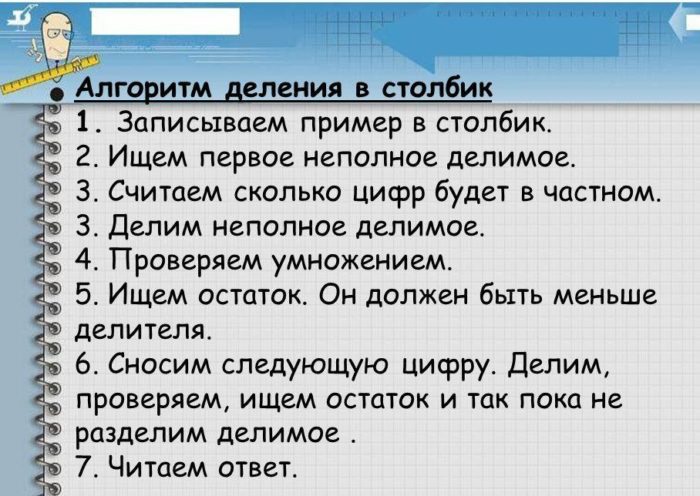
algorithm for dividing numbers by column
For dividing numbers, follow the steps:
- correct the fission on paper correctly. Choose the upper right angle of the notebook / sheet. If you are just learn to perform the action of dividing in the column, take the paper into the cage. So you save the visual sequence of the decision,
- return place between divisible and divider.
You will help the scheme below.
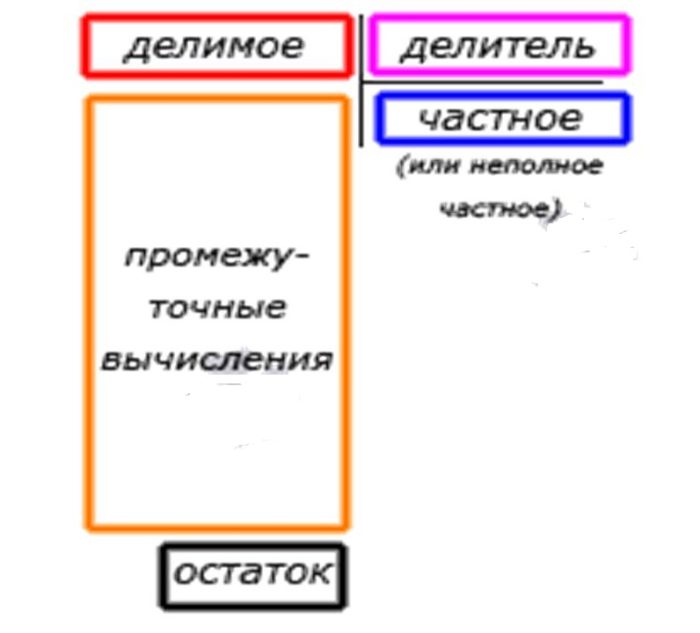
scheme and integration of the component elements of the action of dividing numbers by the column
- plan a space for dividing in a column. The longer the number that is subject to division, and the cow divider, the lower the decision to descend,
- the first action of the division is made with the number of divisory numbers, which is equal to the divider. For example, if you have a unambiguous digit to the right of the dividing line, then consider the first division if two-digit - then the first first,
- multiply the numbers under both the feature and record the result under the divisions that you designate for the first action,
- complete the subtraction and determination of the residue. Draw a horizontal line over it to separate the first step of the decision,
- add the following digit divide to the residue and continue the decision
- the last division step - when you receive from subtracting 0 or a number less divider. In the second case, your answer will be with the residue, for example, 17 and 3 in the residue.
How to explain to the child a division and teach to share a column?

schoolchildren's children train the number of columns
First, consider a number of introductory factors:
- the baby knows the multiplication table
- well disassembled and knows how to apply in practice the actions of subtraction and addition
- understands the difference between the whole and its constituent elements
Further emphasis in your actions look like this:
- play with the multiplication table. Put it in front of the child and on the examples, show the convenience of use in division,
- explain the location of the divide, divider, private, residue. Offer the child to repeat these categories
- turn the process into the game, come up with the story about the numbers and the fission action,
- prepare visual learning items. Accidents are suitable, apples, coins, toys, purified reduction or orange. Offer them to distribute them between different numbers of people, for example, between mom, dad and child,
- the first to show the child action with even numbers so that he saw the result of the division, multiple two.
The process of mastering the division by the Stage:
- write down the numbers, dividing them with the borders. Repeat the location of the division categories with the child,
- invite it to analyze the figures divisible for the "more-less" divider. Help the question - how many times one number is placed in the second. As a result, the child should be selected by the number / numbers that it will be used to perform the first action,
- tell me the algorithm for determining the discharge of private. It is convenient to block it with points, which then turn into numbers,
- help correctly determine and record the first number in private, make it a multiplication to the divider, write down the result under divisible, perform subtraction. Explain that the result of subtraction should always be less than the divider. Otherwise, the action was made with an error and it should be removed,
- the next step is to analyze the situation with the addition of the second number from the division and determination of the number of times the divider in it
- help again with the action record,
- continue until the result when the result from the difference is zero. This is relevant only to divide numbers without a residue,
- secure the knowledge of the child by several more examples. Watch that it is not tired, otherwise you take a break.
How to divide the two-digit number in the column in the column and double-digit: examples, explanation

learning a child dividing the solid
We will proceed to step by step analysis of examples for division in the column.
Perform an action on numbers 25 and 2:
- write them down next and divide the border lines,
- determine the required number of divisible numbers for the first action,
- record the value under the divider and the result of multiplication under divisible,
- perform subtraction
- extract the second divide number and repeat the action to multiply and subtract.
Partially performed task for dividing a two-digit number to a single-valued view below:
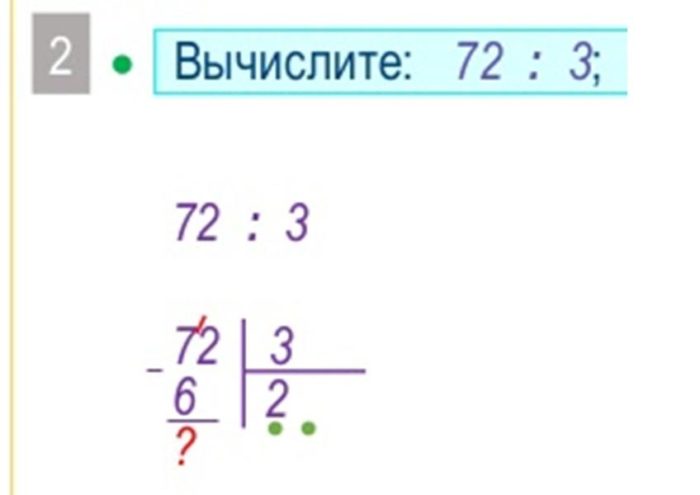
unfinished solution of an example on a division of a double-digit number on a single-valued
Note that the division of a two-digit number on an unambiguous one is possible in one action.
The second example. Divide 87 to 26 in the column.
The algorithm was similar to the considered above with the only difference, which should be considered at once 2 points of the divider when determining the number of times in divis.
To facilitate the task of the child, which is only mastered by the fission, invite it to focus on the first digits of the divide and divider. For example, 8: 2 \u003d 4. Let the child substitute this number under the line and perform multiplication. He needs to see with his own eyes that 4 many and you need to try with a triple.
Below an example of dividing a double-digit number to a double-digit-digit with the residue.
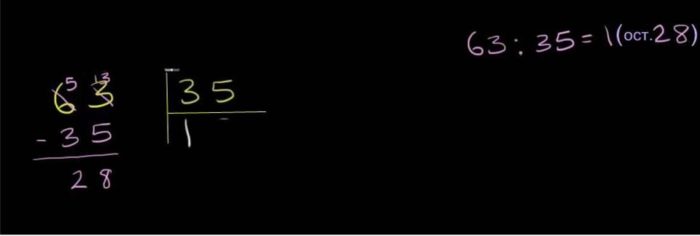
an example of dividing a double-digit number on a double-digit-digit with the residue
Third example. How to split the number in a column with zero in response.
Initially, we divide 15 to 15, in the residue 0, in response 1. Slimming 6, and it is not divided into 15, it means that we put in response 0. Further, 15 multiplied by 0, will be zero and it will take it from 6. Sen one The end of the number, we get 60, which is divided into 15 and in response to put 4.
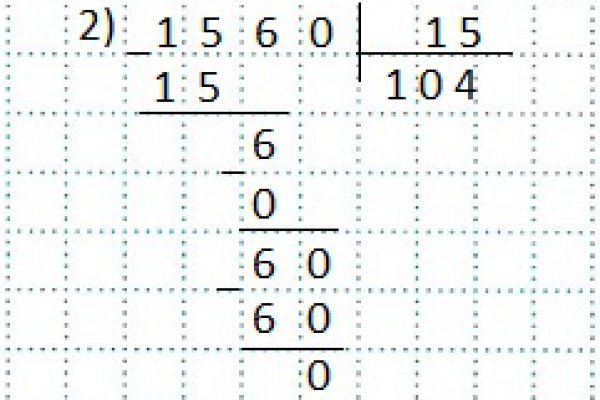
How to divide a three-digit number into a column for one-to-one, double-digit and three-digit: examples, explanation

figure from the presentation on the topic of dividing the three-digit number
Continue the analysis of the division of the column on the examples with three-digit divisible.
When the divider is a single-digit number, the actions algorithm is similar to those discussed above.
Schematically, it looks like this:
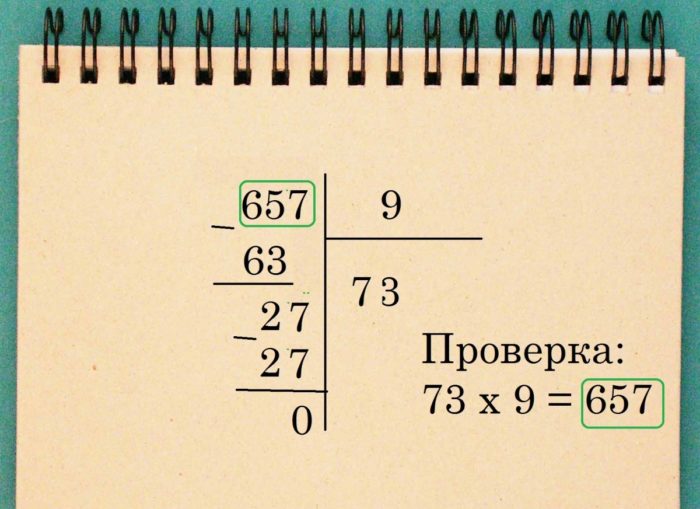
an example of dividing the three-digit number on a single column
In the case of dividing the three-digit divide on a double-digit divider, pick up a number with a child corresponding to the number of second sections in the first part of the first or in general. That is, consider first 2 digits of the three-digit divide, if they are less than a divider, then all three.
When a child just started mastering the division by a column, tell him the accomplishment of actions with unambiguous numbers. That is, with the first in division and divider. Let the kid make an error that will lead to a negative value of subtraction and return to the selection of a number under the line than confusing with the action immediately for a two-digit divider.
The three-digit division scheme on a two-digit number is:
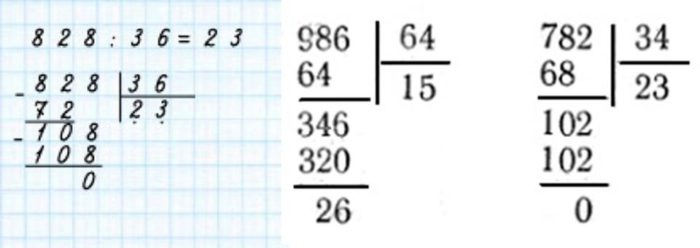
examples of dividing by a column of three-digit numbers on double-digit
Three-digit values \u200b\u200bin the divider and divide look bulky and frightening for the child. Calm it, explaining that the principle of actions is identical, as in the division of prime numbers.
The generation method over one digit will help the baby to deal with each number separately. Only the amount of time for this action will need more than in previous examples. For better visual perception, combine arcs number of numbers that will participate in the first action.
The diagram of dividing the three-digit number.

an example of dividing in a three-digit number on a three-digit with the residue
How to divide four-digit, multivalued large numbers, polynomials: examples, explanation
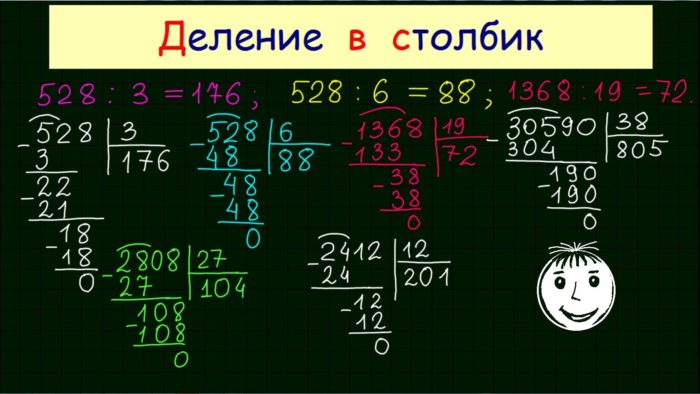
on the board, examples of the division of three- and more meaningful numbers were resolved
In the case of dividing a four-digit number to any, which contains up to 4 orders of magnitude simultaneously, pay attention to the child to the nuances:
- determining the correct amount of orders after the division. For example, in Example 6734: 56, a two-digit integer in the "Private" column will be obtained, and in Example 8956: 1243 - unambiguous integer,
- the appearance of zeros in private. When, during a solution, when transferring the next number, the divisory result turns out to be less than a divider,
- verify the result obtained by performing multiplication. This nuance is relevant to divide large numbers without a residue. If the latter is present, then advise the child to check yourself and once again split the numbers in the column.
Below is an example of a solution.
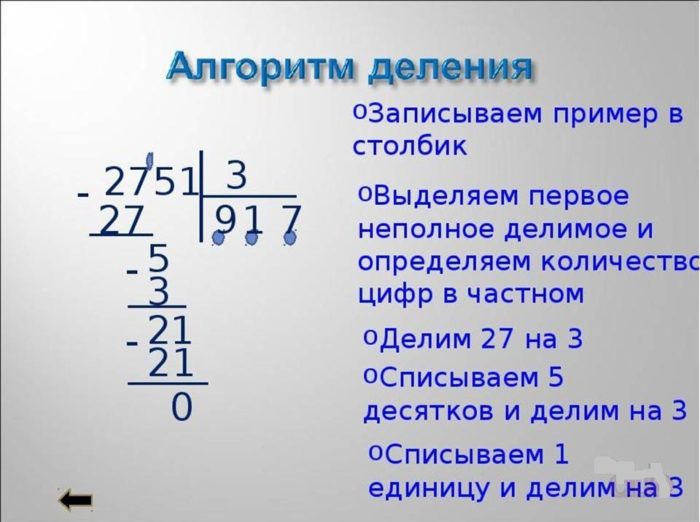
algorithm of division by a four-digit number
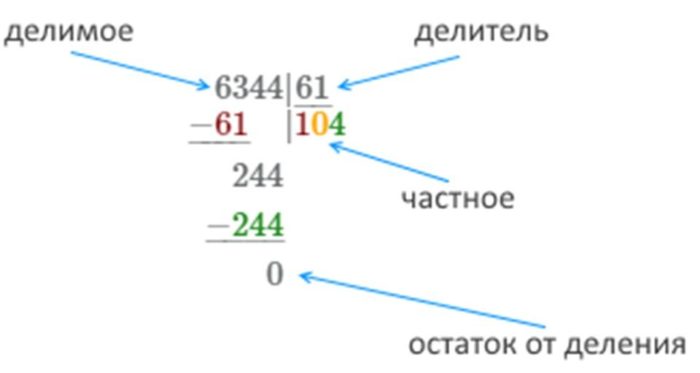
an example of dividing by a four-digit number by a two-digit
For large multivalued numbers, which are divided into specific values \u200b\u200bless than or equal to them by the number of characters, all algorithms discussed above are relevant.
The child should be especially careful in such cases and correctly determine:
- number of characters in private, that is, the result
- figures in division for first action
- the correctness of the transfer of other numbers
Examples of a detailed solution below.
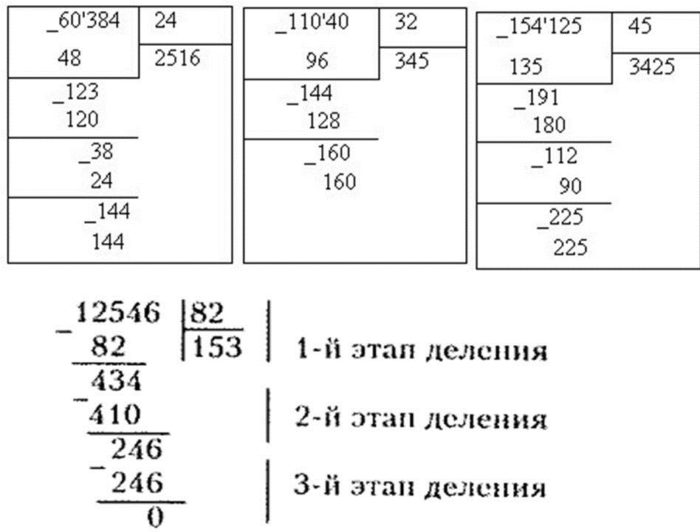
eXAMPLES OF DIFFERENCE OF POLINING MICENSES
When performing the action of division over the polynomials, pay attention to children to a number of features:
- the actions may be the rest or absent. In the first case, write it down in the numerator, and the divider in the denominator,
- to perform subtraction, add the missing degrees of the function multiplied by zero,
- make the transformation of polynomials by selecting repetitive two / polynomials. Then reduce them and turn out the result without a residue.
Below a number of detailed examples with solutions.
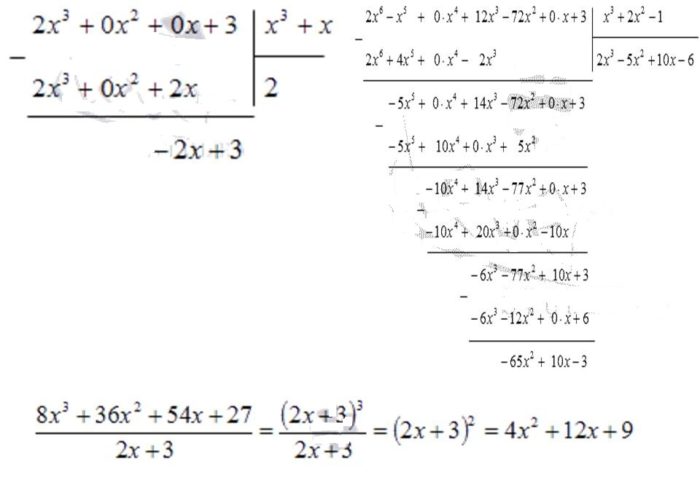
examples of dividing polynomials in the column
How to share in a column with the residue?
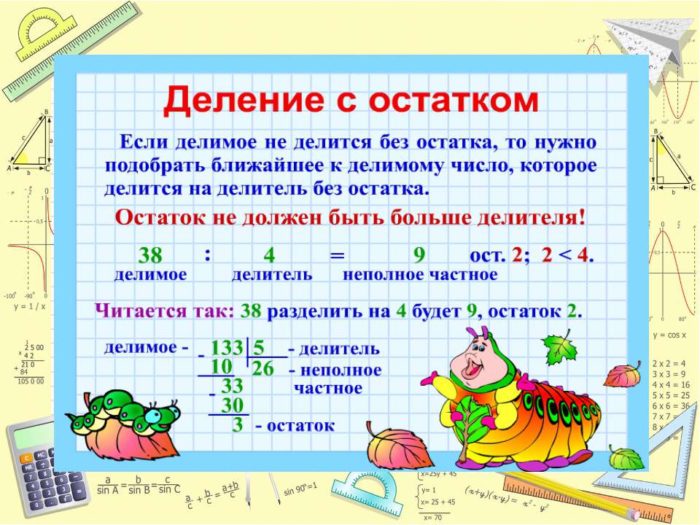
slide from the presentation of the division of numbers with the residue
The division algorithm in the column with the residue is similar to the classic. The difference is only in the appearance of a residue that is less than a divider. So the first remains unchanged.
Record it in response or:
- as a fraction where the balance is in the numerator, and in the denominator - divider
- words, for example, 73 whole and 6 in the remainder
How to share a column decimal with a comma?
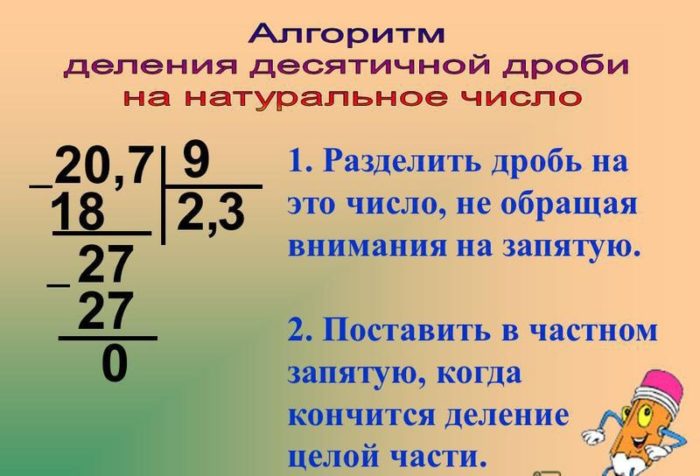
figure with an algorithm of actions when dividing decimal fraction
There are several features with similar division. If you take action with:
- decimal fraction-divisible and integer divider, then act on the usual algorithm until it is time for the figures from the division before the comma. Then put it in private and continue to carry the numbers before the end of the division,
- a number that is divided into 10, 100, 100, etc., then transfer the comma in division to the left to the number of numbers equal to the number of zeros of the divider. For example, 749,5: 100 \u003d 7,495,
- decimal fractions at the same time in the divider, and in Delim, then you first get rid of the comma from the second element. To do this, transfer it to the right in both fractional numbers to the number of signs that are separated from the divider. For example, 416,788: 5.3 Convert to 4167.88: 53 and make a regular division into a column.
How to divide the column a smaller number for more?
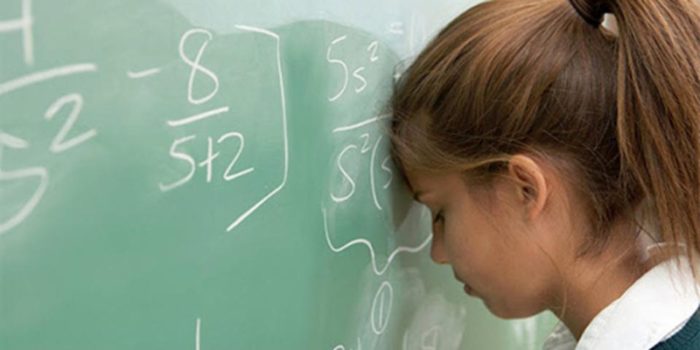
schoolgirl girl is tired of solving examples to divide
With this division, you will begin with 0 and have a comma after it.
So that the child better learned this division and did not get confused in the number of zeros, the place of semicolon in private, give him such an example:
- the first action on subtraction to spend with zeros recorded one by one under the divider and in the "Private" column,
- put the comma in private, and the residue after the difference add zero and continue the usual division into the column,
- when the residue from subtraction is less than a divider again, add the first zero and continue. The final outcome is to obtain a zero from the difference of the upper and lower numbers or repetition of the residue. In the latter case, there is a value in the period, that is, an infinitely repeated number / number.
Below example.
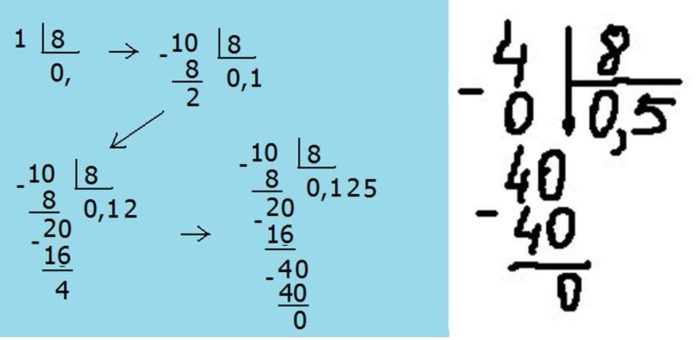
examples of a smaller column division for more
How to share a number with scratch?

smiling girl at school board
The sequence and algorithm of actions is similar to the classical, discussed in the first section.
From the nuances, we note:
- if there is zeros at the end of the divider and we safely reduce them. Offer the child to cross them with a pencil and continue the division as usual. For example, in a 1200: 400 child, a child can remove both zero from both numbers, but in a situation of 15600: 560 - only one to one extreme,
- if the zero is only in the divider, then select the first digit to action, focusing on the number in front of it. For example, in Example 6537: 70, set 9 in the private first. For this example, make multiplication on both digits of the divider and sign them under three in the divide.
When zeros of the division much and the fission process ended before you have used them all, then transfer them to private after the figures that were formed before. Example, 1000: 2 \u003d 500 - You have moved the last two zero.
So, we considered the basic situations of the division of the numbers of a different amount of discharge in the column, identified the actions algorithm and accents for learning a child.
Practice the knowledge gained and help your spell to master mathematics.
